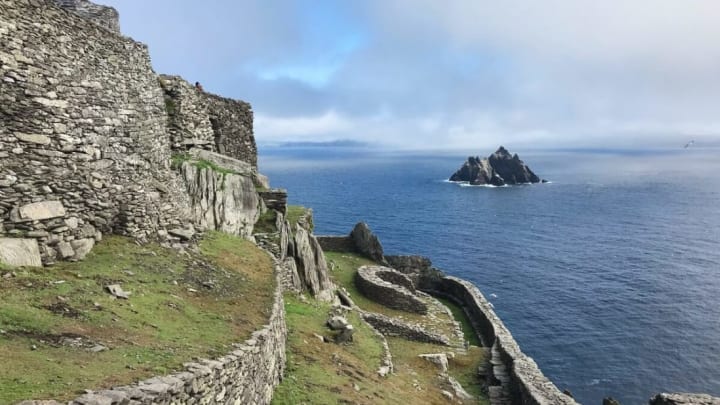Isolation is tough—people have had to endure not seeing friends, spending the holidays and milestones without family, and getting to the end of everything on Netflix. But for medieval monks, isolation wasn't only a way of life, but a means to protect all of Christendom. According to the 5th century's Augustine of Hippo, monks lived in the “City of God,” and their holy work protected those who lived in the “Earthly City,” a.k.a. the rest of us. In other words, the more isolated the monastery, the better. Feast your eyes on five of the world’s most precariously placed monasteries.
1. Saint George Monastery // West Bank

In the early centuries of Christianity, ascetics took a liking to living in the caves around Jerusalem. Around 420 CE, there was a whole cluster of these Christian cave-dwellers (collectively called a lavra) in Wadi Qelt, a river valley in the eastern West Bank. About 80 years later, that lavra was reorganized into a monastery known as The Monastery of Saints John and George of Choziba.
Tucked into a cliff-face (a theme for monasteries, as it turns out), the Saint George Monastery still holds the bones of monks killed when the Persians destroyed the monastery in 614 CE. Much of the monastery was restored between 1878 and 1901 and contains two churches, one of which has a mosaic floor dating back to the 6th century.
2. Taktsang Monastery // Bhutan

Known as the Tiger’s Nest or Tiger’s Lair, the Paro Taktsang monastery is situated 3000 feet up on a mountain face in Bhutan. The monastery gets its nickname from a pretty amazing legend. According to the lore, a Buddhist master named Padmasambhava was looking for a spot to meditate. He hopped on his concubine-turned-flying-tiger and found a nice cave. After vanquishing a couple of demons while meditating, he started converting the Bhutanese population to Buddhism.
Built in 1692, the modern Taktsang Palphug Monastery was constructed around the cave where Padmasambhava (supposedly) got his meditation game on. The monastery includes four main temples and access to eight caves decked out in flickering candles and Bodhisattvas idols. If you want to plan a visit, get ready for a hike—it takes about three hours to reach the monastery on foot.
3. Monastery of the Holy Trinity // Greece

The Meteora rock formation in central Greece is home to quite a few precariously placed monasteries. People have lived in the caves nestled into Meteora for thousands of years—some estimates date the first human cave-dwellers to 50,000 years ago.
The monasteries in Meteora started popping up in the 14th century. As it turns out, Meteora’s rock islands made good monastic sites, as they were easily defensible and very isolated, leading to the construction of 24 total monasteries. Six of the monasteries are still active and open to visitors today. The Monastery of the Holy Trinity is one of the oldest, mostly constructed between 1475–76. Fun fact: the monastery was featured in the 1981 James Bond film For Your Eyes Only.
4. Sumela Monastery // Turkey

Like the Saint George Monastery and the Paro Taktsang Monastery, the Sumela Monastery is all about that cliff-dwelling life. Situated in Northeastern Turkey among the Pontic Mountains, the Sumela Monastery is tucked into a steep cliff-face roughly 3900 feet off the ground. It’s believed that two Athenian monks, Barnabas and Sophronios, founded the monastery around 386 CE. At the time, the monastery’s claim to fame was an idol of the Virgin Mary said to be painted by the Apostle Luke.
Today’s Sumela Monastery dates primarily back to the 13th century, when a vision of the Virgin Mary saved Alexios III, the Emperor of Trebizond, from a storm. The sensible Alexios decided it was high time to restore the monastic site. In 2020, the Sumela Monastery fully reopened to the public after years of restoration.
5. Skellig Michael // Ireland

Ireland’s Skellig Michael is perhaps the most well-known monastic wonder. Situated about seven miles off the country’s southwest coast, the monastic island is made up of 54 acres of rock and juts up to a 714-foot-high point. The monastery on the island was built between the 6th and 8th century, and it’s still in good shape.
Visitors will find stone crosses, two oratories, a cemetery, a medieval church, and six domed beehive cells. It all looks pretty otherworldly— so much so, that the island was actually used as the location for Luke Skywalker's own monastic retreat in the latest Star Wars trilogy. When the playwright George Bernard Shaw visited the site in 1910, he aptly described this "incredible, impossible, mad place" as "part of our dream world."
